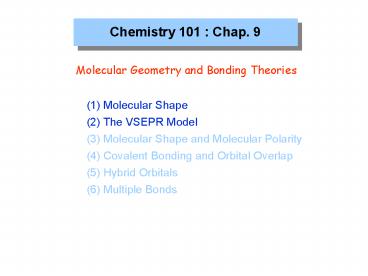Chemistry 101 : Chap' 9 PowerPoint PPT Presentation
1 / 14
Title: Chemistry 101 : Chap' 9
1
Chemistry 101 Chap. 9
Molecular Geometry and Bonding Theories
- Molecular Shape
- (2) The VSEPR Model
- (3) Molecular Shape and Molecular Polarity
- (4) Covalent Bonding and Orbital Overlap
- (5) Hybrid Orbitals
- (6) Multiple Bonds
2
Molecular Shape
? 3-dimensional rendering of a molecule (example
CH4)
Structural Formula
Perspective drawing
tetrahedral
Space-filling model
Ball-and-stick model
3
Molecular Shape
? Five fundamental shapes of ABn
bond angle
4
Molecular Shape
? Derivatives from the ABn geometries
Additional molecular shapes can be obtained by
removing corner atoms from the basic shape
5
VSEPR Model
Valence-Shell Electron-Pair Repulsion The
geometry around a central atom is determined by
the number of bonding pair of electrons
and non-bonding pair (lone pair) electrons
surrounding the atom.
6
Electron Domain
? Electron Domain A region surrounding the
central atom in which the electrons (bonding
or nonbonding pair) are likely to be found
VSEPR and Electron Domain
The electron domains in an atom get as far
apart from each other as possible The
best arrangement of electron domains is the one
that minimizes the repulsions among them.
7
Electron Domain
? Example How many electron domains do NH3 and
O3 have?
8
Electron Domain Geometry
? Electron-Domain Geometry The arrangement of
electron domains about the central atom of
a molecule or ion
9
Electron Domain Geometry
10
Molecular Geometry
- Molecular Geometry The arrangement of only the
atoms around - the central
atom
- If all the electron domains arises from bonding
pair, - electron-domain geometry molecular
geometry
(2) If one or more electron-domains arise from
nonbonding pairs, ignore such domain to
predict the molecular geometry
11
Molecular Geometry
? Procedure to determine a molecular structure
- Draw a Lewis structure and count the total
number of - electron domains around the central atom
(2) Determine the electron-domain geometry by
arranging the electron domains to minimize
the repulsions among them.
(3) Use the arrangement of the bonded atoms to
determine the molecular geometry
12
Molecular Geometry
? Example Use VSEPR model to predict the
molecular geometry of O3,
H2O, and NH4
13
Molecular Geometry
? Effect of multiple bonding on bond angle
Because multiple bonds contain higher
electron-charge density than single bonds,
multiple bonds represent larger electron domain
? Effect of nonbonding electrons on bond angle
- Nonbonding pair
- experience less nuclear
- attraction
- larger electron domain
14
Molecular Geometry
? Example Predict the geometry of IF5 and SF4

